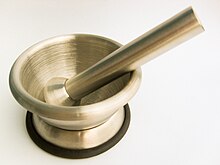臼
Translingual
| Stroke order | |||
|---|---|---|---|

| |||
Han character
臼 (Kangxi radical 134, 臼+0, 6 strokes, cangjie input 竹難 (HX), four-corner 77770)
- Kangxi radical #134, ⾅.
Derived characters
References
- Kangxi Dictionary: page 1003, character 1
- Dai Kanwa Jiten: character 30173
- Dae Jaweon: page 1459, character 11
- Hanyu Da Zidian (first edition): volume 5, page 3037, character 1
- Unihan data for U+81FC
Chinese
| simp. and trad. |
臼 | |
|---|---|---|
Glyph origin
| Historical forms of the character 臼 |
|---|
| Shuowen Jiezi (compiled in Han) |
| Small seal script |

|
Pictogram (象形) : a mortar
Pronunciation
- Mandarin
- Cantonese (Jyutping): kau3 / kau5
- Hakka (Sixian, PFS): khiu, khíu
- Southern Min (Hokkien, POJ): khǔ / khū / kiǔ / kiū
- Mandarin
- (Standard Chinese)+
- Hanyu Pinyin:
- Zhuyin: ㄐㄧㄡˋ
- Tongyong Pinyin: jiòu
- Wade–Giles: chiu4
- Yale: jyòu
- Gwoyeu Romatzyh: jiow
- Palladius: цзю (czju)
- Sinological IPA (key): /t͡ɕi̯oʊ̯⁵¹/
- (Standard Chinese)+
- Cantonese
- (Standard Cantonese, Guangzhou–Hong Kong)
- Jyutping: kau3 / kau5
- Yale: kau / káuh
- Cantonese Pinyin: kau3 / kau5
- Guangdong Romanization: keo3 / keo5
- Sinological IPA (key): /kʰɐu̯³³/, /kʰɐu̯¹³/
- (Standard Cantonese, Guangzhou–Hong Kong)
- Hakka
- (Sixian, incl. Miaoli and Neipu)
- Pha̍k-fa-sṳ: khiu, khíu
- Hakka Romanization System: kiu, kiuˋ
- Hagfa Pinyim: kiu4, kiu3
- Sinological IPA: /kʰi̯u⁵⁵ kʰi̯u³¹/
- (Sixian, incl. Miaoli and Neipu)
- Southern Min
- (Hokkien: Quanzhou)
- Pe̍h-ōe-jī: khǔ
- Tâi-lô: khǔ
- IPA (Quanzhou): /kʰu²²/
- (Hokkien: General Taiwanese, Xiamen, Zhangzhou)
- Pe̍h-ōe-jī: khū
- Tâi-lô: khū
- Phofsit Daibuun: qu
- IPA (Xiamen, Zhangzhou): /kʰu²²/
- IPA (Taipei, Kaohsiung): /kʰu³³/
- (Hokkien: Quanzhou)
- Pe̍h-ōe-jī: kiǔ
- Tâi-lô: kiǔ
- IPA (Quanzhou): /kiu²²/
- (Hokkien: Xiamen, Zhangzhou)
- Pe̍h-ōe-jī: kiū
- Tâi-lô: kiū
- Phofsit Daibuun: kiu
- IPA (Xiamen, Zhangzhou): /kiu²²/
- (Hokkien: Quanzhou)
Note:
- khǔ/khū - vernacular;
- kiǔ/kiū - literary.
- Middle Chinese: gjuwX
- Old Chinese
- (Baxter–Sagart): /*C.[ɡ]ʷəʔ/
- (Zhengzhang): /*ɡuʔ/
Definitions
Compounds
Lua error in Module:zh/templates at line 32: This template has been deprecated. Please use Template:col3 instead.
References
Japanese
Kanji
臼
Readings
Etymology
| Kanji in this term |
|---|
| 臼 |
| うす Grade: S |
| kun'yomi |

From Proto-Japonic *osu ~ usu.
Pronunciation
Lua error in Module:parameters at line 828: Parameter "y" is not used by this template.
Noun
See also
Korean
Hanja
臼 (eum 구 (gu))
- This term needs a translation to English. Please help out and add a translation, then remove the text
{{rfdef}}.
Vietnamese
Han character
- This term needs a translation to English. Please help out and add a translation, then remove the text
{{rfdef}}.
Categories:
- Han character radicals
- Translingual lemmas
- Translingual symbols
- Han script characters
- Han pictograms
- Chinese lemmas
- Mandarin lemmas
- Cantonese lemmas
- Hakka lemmas
- Hokkien lemmas
- Middle Chinese lemmas
- Old Chinese lemmas
- Chinese hanzi
- Mandarin hanzi
- Cantonese hanzi
- Hakka hanzi
- Hokkien hanzi
- Middle Chinese hanzi
- Old Chinese hanzi
- Chinese nouns
- Mandarin nouns
- Cantonese nouns
- Hakka nouns
- Hokkien nouns
- Middle Chinese nouns
- Old Chinese nouns
- Chinese terms with IPA pronunciation
- Chinese terms spelled with 臼
- Japanese kanji
- Japanese jōyō kanji
- Japanese kanji with goon reading ぐ
- Japanese kanji with kan'on reading きゅう
- Japanese kanji with historical kan'on reading きう
- Japanese kanji with kun reading うす
- Japanese terms spelled with 臼 read as うす
- Japanese terms read with kun'yomi
- Japanese terms inherited from Proto-Japonic
- Japanese terms derived from Proto-Japonic
- Japanese lemmas
- Japanese nouns
- Japanese terms spelled with secondary school kanji
- Japanese terms with 1 kanji
- Japanese terms spelled with 臼
- Japanese single-kanji terms
- Korean lemmas
- Korean hanja
- Vietnamese lemmas
- Vietnamese Han characters
- CJKV radicals
